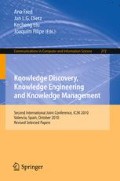Abstract
We study a connection between extreme learning machine (ELM) and neural network kernel (NNK). NNK is derived from a neural network with an infinite number of hidden units. We interpret ELM as an approximation to this infinite network. We show that ELM and NNK can, to certain extent, replace each other. ELM can be used to form a kernel, and NNK can be decomposed into feature vectors to be used in the hidden layer of ELM. The connection reveals possible importance of weight variance as a parameter of ELM. Based on our experiments, we recommend that model selection on ELM should consider not only the number of hidden units, as is the current practice, but also the variance of weights. We also study the interaction of variance and the number of hidden units, and discuss some properties of ELM, that may have been too strongly interpreted previously.
Access this chapter
Tax calculation will be finalised at checkout
Purchases are for personal use only
Preview
Unable to display preview. Download preview PDF.
References
Huang, G.B., Zhu, Q.Y., Siew, C.K.: Extreme learning machine: Theory and applications. Neurocomputing 70, 489–501 (2006)
Rasmussen, C.E., Williams, C.K.I.: Gaussian processes for machine learning. MIT Press (2006)
Frénay, B., Verleysen, M.: Using SVMs with randomised feature spaces: an extreme learning approach. In: Proc. of ESANN, pp. 315–320 (2010)
Miche, Y., Sorjamaa, A., Bas, P., Simula, O., Jutten, C., Lendasse, A.: OP-ELM: Optimally pruned extreme learning machine. IEEE Transactions on Neural Networks 21, 158–162 (2010)
Zhu, Q.Y., Qin, A.K., Suganthan, P.N., Huang, G.B.: Evolutionary extreme learning machine. Pattern Recognition 38, 1759–1763 (2005)
Penrose, R.: A generalized inverse for matrices. Mathematical Proceedings of the Cambridge Philosophical Society 51, 406–413 (1955)
McCullagh, P., Nelder, J.A.: Generalized linear models, 2nd edn. Monographs on statistics and applied probability, vol. 37. Chapman & Hall (1989)
Williams, C.K.I.: Computation with infinite neural networks. Neural Computation 10, 1203–1216 (1998)
Cho, Y., Saul, L.K.: Kernel methods for deep learning. In: Bengio, Y., Schuurmans, D., Lafferty, J., Williams, C., Culotta, A. (eds.) Proc. of NIPS, vol. 22, pp. 342–350 (2009)
Vert, J.P., Tsuda, K., Schölkopf, B.: A primer on kernel methods. In: Schölkopf, B., Tsuda, K., Vert, J.P. (eds.) Kernel Methods in Computational Biology, pp. 35–70. MIT Press (2004)
Asuncion, A., Newman, D.: UCI machine learning repository (2007)
Guyon, I., Gunn, S.R., Ben-Hur, A., Dror, G.: Result analysis of the NIPS 2003 feature selection challenge. In: Proc. of NIPS (2004)
Minka, T.: Expectation propagation for approximate Bayesian inference. In: Proc. of UAI (2001)
Young, G., Householder, A.S.: Discussion of a set of points in terms of their mutual distances. Psychometrika 3, 19–22 (1938)
Golub, G.H., Van Loan, C.F.: Matrix computations, 3rd edn. The Johns Hopkins University Press (1996)
Parviainen, E., Riihimäki, J., Miche, Y., Lendasse, A.: Interpreting Extreme Learning Machine as an approximation to an infinite neural network. In: Proc. of KDIR. INSTICC (2010)
Bartlett, P.L.: The sample complexity of pattern classification with neural networks: the size of the weights is more important than the size of the network. IEEE Transactions on Information Theory 44, 525–536 (1998)
Author information
Authors and Affiliations
Editor information
Editors and Affiliations
Rights and permissions
Copyright information
© 2013 Springer-Verlag Berlin Heidelberg
About this paper
Cite this paper
Parviainen, E., Riihimäki, J. (2013). A Connection between Extreme Learning Machine and Neural Network Kernel. In: Fred, A., Dietz, J.L.G., Liu, K., Filipe, J. (eds) Knowledge Discovery, Knowledge Engineering and Knowledge Management. IC3K 2010. Communications in Computer and Information Science, vol 272. Springer, Berlin, Heidelberg. https://doi.org/10.1007/978-3-642-29764-9_8
Download citation
DOI: https://doi.org/10.1007/978-3-642-29764-9_8
Publisher Name: Springer, Berlin, Heidelberg
Print ISBN: 978-3-642-29763-2
Online ISBN: 978-3-642-29764-9
eBook Packages: Computer ScienceComputer Science (R0)

